Keyword Clustering is a powerful SEO technique that groups related keywords into clusters, helping websites rank higher by targeting multiple search queries at once. At OctopusWriters, we believe that understanding how to create keyword clusters can significantly enhance your content strategy and boost organic traffic. By efficiently grouping keywords based on search intent, you can avoid keyword cannibalization and improve the relevance of your pages. Whether you’re using manual methods or automated tools, mastering keyword clustering can lead to more targeted content, better internal linking, and an overall stronger SEO presence.
What is keyword?
A keyword is a specific word or phrase that users enter into search engines to find information, products, or services online. Keywords are crucial in SEO (Search Engine Optimization) as they help connect search queries with relevant content on websites. By strategically including the right keywords in your content, you improve the chances of your page ranking higher on search engine results pages (SERPs).
For example, when someone searches for “best running shoes,” the search engine looks for web pages optimized for that keyword. Effective keyword use ensures your content meets both user intent and search engine algorithms, enhancing visibility and traffic.
What is keyword clustering?
Keyword clustering involves grouping similar terms based on the searcher’s intent, which refers to their underlying goal when typing a query. For instance, someone looking for “king size mattress” or “king mattress” essentially seeks the same product. As a result, search engines like Google often show comparable results for both.
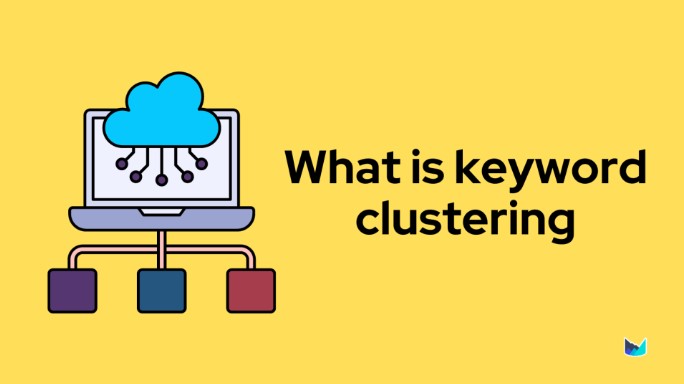
This process is crucial in SEO because users may search for a single page in various ways. Identifying all relevant keywords enables you to optimize content to rank for a wider range of queries. While the main focus should be on a primary keyword, including secondary terms—such as synonyms (e.g., “king size mattress” and “king mattress”) and long-tail variations (e.g., “king size mattress with box springs”)—broadens the scope. For example, Mattress Firm’s king mattress page ranks for over 1,800 keywords, generating approximately 197,800 organic U.S. visits per month.

While it’s possible to rank for multiple keywords without deliberate clustering, doing so enhances the likelihood. Additionally, incorporating related terms into your content can inspire new subtopics, resulting in more comprehensive and natural-sounding content. This, in turn, can boost both rankings and user engagement.
Keyword clustering also reveals a broader perspective on SEO opportunities. A single keyword may seem to have low search volume, but when grouped with related terms, the collective search demand may be much higher. This approach helps optimize time and effort in content creation.
Keyword clustering example
Think about how people search when they’re trying to find something—they don’t always use the exact same phrase. Instead, they try different combinations of terms to help Google pinpoint the best result.
For instance, someone typing “chocolate chip cookie dough recipe” or “chocolate chip cookie recipe” is essentially searching for the same thing. Here’s an example of what the top results for both searches might look like:

Those search engine results pages (SERPs) are nearly indistinguishable from these:

To effectively reach all potential users, your keyword cluster should encompass both terms.
Benefits of Keyword Clustering
Improved SEO Performance: Organizing keywords into clusters allows for the creation of more detailed and relevant content. This strategy helps improve search engine rankings by thoroughly addressing user queries, which makes your content more authoritative in the eyes of search algorithms.
Better User Experience: By clustering keywords, you can develop content that meets a broader range of user needs. This enhances the value of your site to visitors, ensuring they find the information they’re looking for and creating a more satisfying experience.
Simplified Content Creation: Focusing solely on a single keyword can make producing a large volume of content challenging. However, with keyword clustering, you can focus on related terms, making it easier to generate unique, relevant material.
Improved Website Structure: Keyword clustering helps organize your site more effectively. Each keyword group can form a category or subcategory, enhancing user navigation. Additionally, similar clusters can be grouped into “topic clusters,” creating a more cohesive content structure, which will be further explained later.
How does keyword clustering work?
Keyword clustering begins with thorough keyword research and a semantic analysis process, typically done using tools like Ahrefs, SEMrush, or Google Keyword Planner. These tools provide insights into key metrics such as search volume, keyword difficulty, and offer keyword suggestions, helping you compile a comprehensive list of potential keywords.
The next step is to categorize and group keywords based on similar search intent and relevance. Central keywords, which represent the main themes or topics, form the foundation of these clusters.
Advanced technologies like Natural Language Processing (NLP) and search engine algorithms play a critical role in deciphering the semantic relationships between keywords and content. This allows you to design pillar pages that link to related subtopics, creating interconnected content clusters, which help boost SEO performance.
An effective keyword clustering strategy not only enhances your SEO but also improves website organization. This ensures a more user-friendly structure where relevant content is easily accessible, improving the overall user experience.
Types of Keyword Clustering: Semantic Clustering vs SERP Clustering
Semantic Clustering
Semantic keyword clustering involves using NLP (Natural Language Processing) to group keywords based on their meanings and how closely they relate. NLP, which falls under the umbrella of artificial intelligence, is concerned with the interaction between computers and human language. It enables machines to comprehend, interpret, and produce human language in meaningful ways.
When used in keyword clustering, NLP tools analyze and interpret the meanings of various keywords, establishing connections between them. This allows for the creation of keyword clusters that revolve around similar core topics, all linked by their semantic relationships.
SERP Clustering
Alternatively, SERP-based keyword clustering focuses on grouping keywords that produce similar URLs in search engine results. The concept here is that if specific keywords consistently appear together in search results, they likely share a strong connection and should be targeted in the same piece of content.
This technique depends heavily on how search engines evaluate the relationships between keywords and express these relationships through the SERP results.
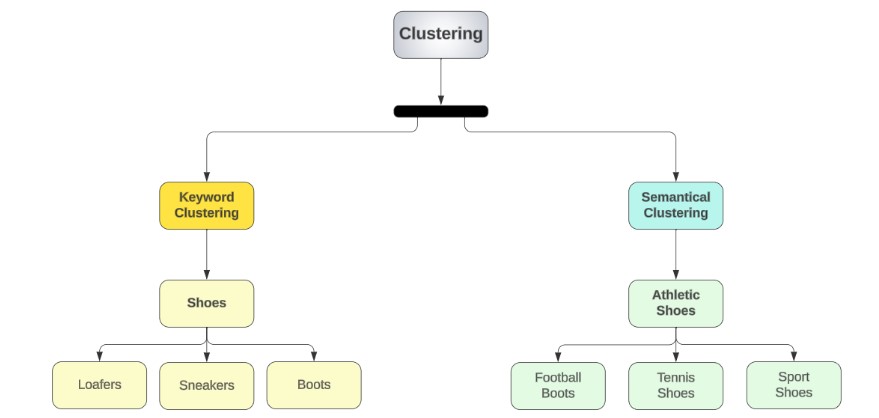
In essence, semantic keyword clustering powered by NLP focuses on grasping and interpreting the deeper meanings and relationships between keywords. On the other hand, SERP-based keyword clustering derives connections from how keywords co-occur in search engine results.
Naturally, both approaches have their respective advantages and disadvantages.
Pros and Cons of Semantic Clustering
The primary advantages of semantic clustering include its affordability, often being free. Numerous Python scripts available online allow users to access NLP libraries that can group words based on their meaning similarity without any cost. Additionally, the results can sometimes appear clearer and more straightforward compared to those generated by SERP-based clustering tools, which I will discuss further in the next section.
However, the most significant drawback—and it’s quite substantial—is that we are operating within the framework set by Google. To attract visitors to our site, we must ensure that we don’t overlook the creation of any relevant pages. Semantic clustering can group keywords that seem related, yet search engines may display vastly different results for each term. This inconsistency highlights the risk of missing opportunities to create a broader array of content that could better address various search intents.
For example, many vaping websites feature a single page that targets both “vaporizer parts” and “vaporizer accessories.” At first glance, this seems logical since they refer to similar items. Depending on the specific algorithms used, most NLP-driven clustering tools would likely classify these two terms together due to their semantic similarity.
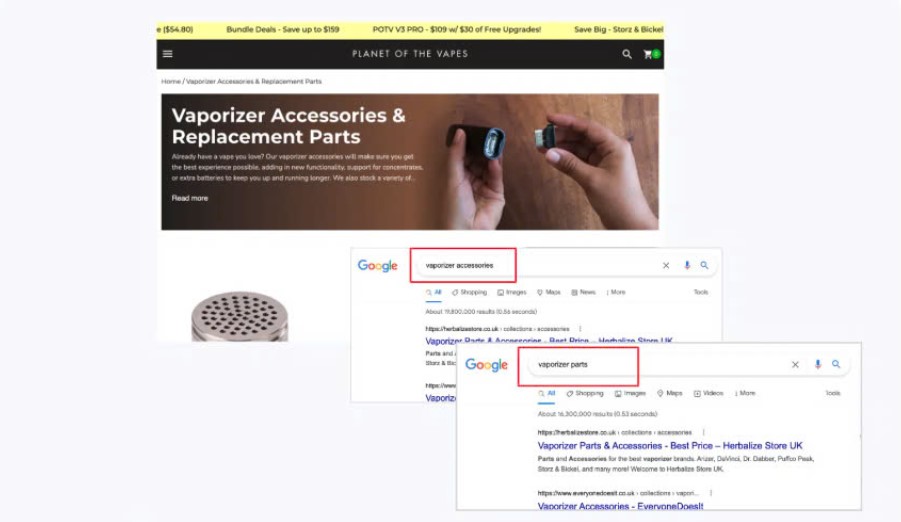
However, when we utilize a SERP-based clustering tool, the outcomes reveal significant differences, showing only an 11.8% similarity between the terms. For this particular client, as well as for most vaping websites, it would be advisable to create two distinct pages to effectively target these two high-volume queries if the goal is to enhance visibility for both.
This approach ensures that each keyword receives the focus it deserves, allowing for better optimization and a higher chance of ranking well in search engine results.
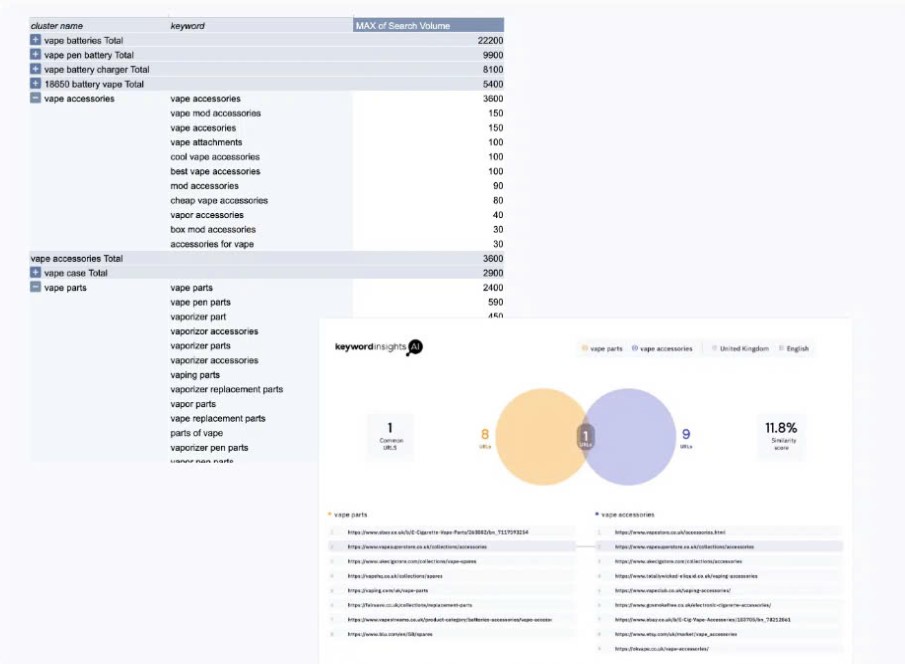
Pros and Cons of SERP Clustering
Advantages of SERP Clustering
The primary benefit of SERP-based clustering is its alignment with Google’s ecosystem. This concept essentially mirrors the earlier point about the necessity of adapting our optimization strategies to fit search engine outputs. Since search engines can yield different results for similar queries due to various factors like experimentation, algorithmic nuances, and user feedback, it becomes crucial to understand these variations. For example, the distinction between “skateboard wheel” and “skateboard wheels” illustrates different search intents: the former typically indicates a focus on technical specifications, while the latter is more geared toward making a purchase. This demonstrates how even slight changes in keywords can profoundly affect perceived intent.
Disadvantages of SERP Clustering
The most significant drawback is that it invariably incurs costs; scraping data is not free. Additionally, the outcomes can sometimes be perplexing. SERP clustering may lead to what I refer to as “keyword cluster fragmentation.” This occurs when two or more clusters appear to be similar and do not necessarily require separate pages for targeting. For a deeper understanding of this phenomenon, there’s a video at the bottom of this page explaining “keyword cluster fragmentation” in detail. You can skip to the 6-minute and 30-second mark, where it’s explained in about two minutes.
Given the substantial advantages that SERP clustering offers, Keyword Insights was developed as a dedicated SERP-based clustering tool to streamline this process.
How to do keyword clustering
Now that you have a better grasp of keyword clustering and its significance for your business, let’s explore some effective strategies for executing keyword clustering properly and creating your topic clusters.
Compile Your Keyword List
Start by gathering the keywords that your competitors’ content is currently ranking for. This will help you identify related keywords that can be integrated into your strategy, as well as the key industry terms that will be important for your future efforts.
Organize Your Keywords into Categories
Once you have your initial keyword data, begin sorting your keywords into groups based on the search intent behind each one. This organization will help clarify your strategy moving forward.
Develop and Optimize Pillar Pages for Your Clusters
The structured keyword lists you’ve created will assist you in planning your content strategy. Grouping keyword clusters into pillar pages allows you to effectively organize your topic clusters and optimize them according to best SEO practices.
Spot Content Gaps and Formulate a Strategy
Leverage your keyword research to identify any content gaps within your competitors’ offerings. By doing this, you can carve out a niche for yourself and devise a strategy that differentiates you in the market.
Support Your Keyword Clusters with Blog Content
Now that your keyword clusters are established, you can begin crafting blog content that aligns with those clusters, reinforcing your primary keywords. This step is crucial as it involves creating actual content that utilizes your keyword clusters and captures the search intent you aim to rank for.
Understanding Topical Clusters vs Keyword Clusters
At times, you might come across the terms “topical clusters” and “keyword clusters” being used interchangeably, but it’s important to understand the distinctions between them.
As previously mentioned, a keyword cluster refers to a collection of similar keywords that have been grouped together. These keywords can (and should) be targeted on the same page, as they typically convey the same meaning or intent.
Introducing Topical Clusters
On the other hand, topical clusters can be thought of as “mega clusters.” When organizing content on your website, topical clusters involve thematically linking and grouping related keyword clusters together. You can think of it as “clustering your clusters.”
For example, in the screenshot below, you might see at least six “keyword clusters” associated with conducting keyword research for Amazon. This demonstrates how broader themes can encompass various specific keyword sets, allowing for a more comprehensive content strategy.
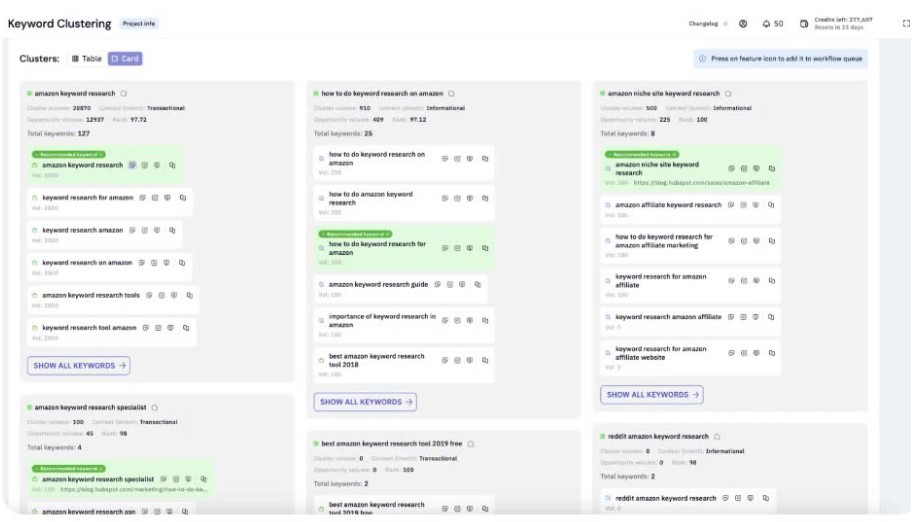
Examining the clusters, some potential titles for these guides could include:
- How to Conduct Keyword Research on Amazon
- A Guide to Niche Site Keyword Research for Amazon
- The Best Keyword Research Tools for Amazon
- How to Find a Keyword Research Specialist for Amazon
It’s clear that these topics are closely related, as they all revolve around keyword research specific to Amazon. By producing these articles and linking them on your site, you effectively create a “topical cluster” centered around “Amazon Keyword Research.”
In essence, a collection of keyword clusters that are topically related can be combined to form what is known as a “topic cluster.”
Within Keyword Insights, we aim to simplify the identification of these “topic clusters.” By utilizing the ‘clustering projects’ feature, you can easily access the ‘Topical clusters’ option, which provides a report that groups similar clusters, streamlining your content planning process. In the accompanying screenshot, you’ll observe all the clusters related to “Amazon” grouped within a larger circle.
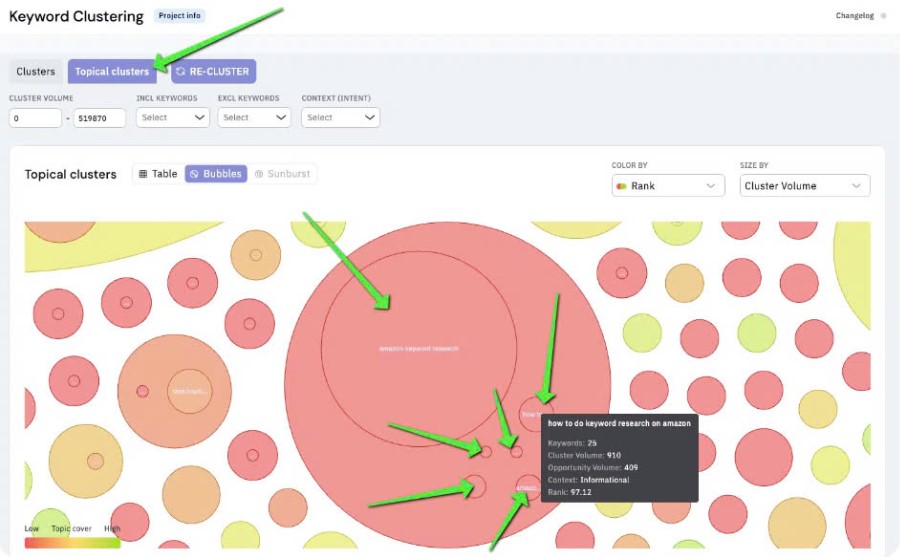
In this report, the red ‘circles’ highlight topics that your target domain is not currently ranking for, with the circle’s size indicating the search volume. This feature aids in uncovering significant topical clusters that your existing content may overlook.
Components of a Topic Cluster
A topical cluster primarily comprises interlinked webpages (or keyword clusters) that revolve around a central theme. While it is generally recommended—though not required—to connect all related keyword clusters through a core ‘pillar’ page, this practice helps enhance the structure and SEO of your content. For example, in the previously mentioned scenario, you might visualize it as shown in the image below.
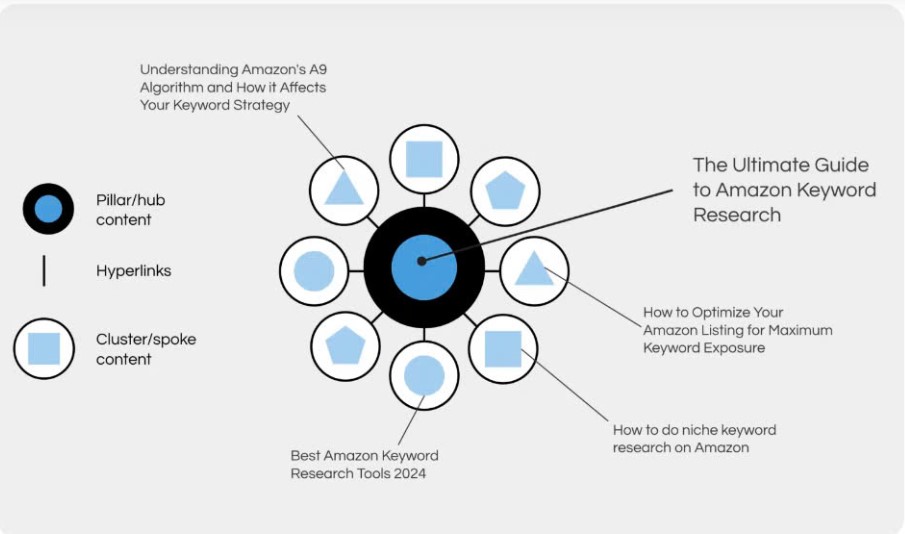
Each piece of content within a “cluster” is appropriately linked to one another, all connected through a central “hub” or “pillar” content piece. In this instance, “The Ultimate Guide to Amazon Keyword Research” serves as the pillar. However, it’s advisable to avoid using the term “Ultimate Guides” in your titles. For further insights on this, check out our detailed post on the topic.
What is a Pillar Page?
The pillar page provides a comprehensive overview of the main topic and includes links to the associated ‘cluster’ pages. Each of these cluster pages delves deeper into specific aspects of the overarching theme and links back to the pillar page. This interconnected structure creates a rich and easily navigable network of content surrounding a specific topic.
Thus, “Creating topical clusters” refers to a methodical strategy for planning, drafting, and linking related content on your website. This approach allows you to thoroughly explore a subject, ensuring a well-rounded and interconnected content framework that aids in the transfer of page rank among significant pages.
It’s also important to note that many people refer to this strategy of organizing and grouping content as the “hub and spoke” model of content creation, where the hub represents the pillar, and the spokes are the keyword clusters.
The drawback to keyword clustering
Results from keyword clustering are rarely flawless and often subject to interpretation.
For instance, consider the keyword “best chocolate cake recipe with coffee.” Both Ahrefs and the keyword clustering tool I used categorized this under the “chocolate cake” topic. This occurs due to overlapping search results. Exactly. For some reason, Google ranks a combination of plain chocolate cake recipes alongside chocolate cake recipes that include coffee for this keyword.

As a result, it’s not always clear whether you should target both keywords on the same page.
In situations like this, examining the metrics of the top-ranking pages can offer better insight. For instance, consider analyzing the number of referring domains and the Domain Rating (DR) of these pages.
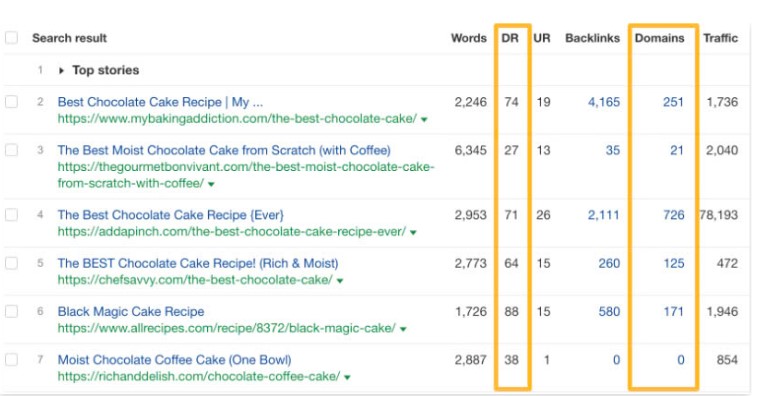
See anything? That’s right. The metrics for chocolate cake recipes with coffee are significantly lower compared to those for pure chocolate cake recipes. Here are the numbers:

Tools and resources for keyword clustering
There are various tools and resources that can simplify the process of keyword clustering:
Ahrefs and SEMrush: These popular keyword research platforms are invaluable for gathering comprehensive data on metrics such as search volume, keyword difficulty, and related keywords. Both platforms also offer features for keyword grouping and analysis based on SERP (Search Engine Results Page) similarities. They are especially effective for conducting the initial stages of keyword research.
Keyword Clustering Tools: Specialized tools like Keyword Insights or DemandJump are designed to automatically cluster keywords based on factors like semantic similarity, search intent, and patterns in SERP behavior. These tools focus specifically on organizing keywords efficiently.
Excel and Google Sheets: While they require manual effort, spreadsheets like Excel or Google Sheets remain useful for visualizing and managing keyword clusters, particularly for smaller projects where advanced automation isn’t necessary.
Content Optimization Tools: Solutions such as Clearscope (a content optimization tool) assist in ensuring that you’re using the most appropriate keywords while perfectly aligning with the search intent behind those queries. Instead of spending hours manually clustering keywords, Clearscope streamlines this process to ensure that your content includes the right terms with minimal effort.
This approach ensures you get the most out of keyword clustering, whether you’re using advanced tools or manual methods.
Future Trends in Keyword Clustering
How AI is Shaping the Future of Keyword Clustering
Artificial intelligence (AI) is revolutionizing keyword clustering by automating the process and providing deeper insights. AI algorithms can analyze large datasets of search terms and user behavior to detect patterns that would be impossible for manual processes. Through natural language processing (NLP) and machine learning, AI can identify synonyms, related terms, and variations in user intent, enabling more accurate keyword clusters.
This allows marketers to focus on creating content that covers broad topic areas comprehensively. Moreover, AI can adjust clusters in real time, keeping up with trends and shifts in user intent, ensuring that content remains relevant. As AI continues to advance, keyword clustering will become more dynamic, with clusters evolving automatically based on the latest search engine results and user behaviors.
The Role of Voice Search in Keyword Grouping
With the rise of voice search, keyword grouping is becoming increasingly conversational. Voice search queries tend to be longer and more natural in tone compared to traditional typed searches. This shift requires marketers to rethink their keyword clustering strategies. Instead of focusing on short, isolated keywords, clustering now needs to include question-based and conversational phrases that reflect how users speak.
For instance, instead of optimizing for “best shoes,” clusters should include phrases like “what are the best shoes for running?” or “where can I buy affordable running shoes?” As voice search continues to grow, understanding and grouping these long-tail, conversational queries will be essential for effective keyword clustering and SEO success.
Real-time SERP Analysis for Clustering
Real-time SERP (Search Engine Results Page) analysis is becoming a key component in keyword clustering, providing instant insights into how specific keywords and topics are performing. By analyzing the top-ranking pages for a given search term, real-time SERP analysis helps marketers understand what content search engines favor.
This can inform more strategic keyword clustering by identifying patterns in content structure, meta descriptions, and user intent behind queries. It enables marketers to cluster keywords based on what is currently working in the search landscape, allowing for real-time adjustments to SEO strategies. By integrating real-time SERP data into keyword clustering, businesses can stay ahead of competitors and optimize their content for better rankings and user engagement.
These advancements in keyword clustering, driven by AI, voice search, and real-time data analysis, are shaping the future of SEO, making it more responsive, personalized, and effective.
FAQs about Keyword Clustering
Q: Can you provide an example of keyword clustering?
A: Sure! Let’s say you run a blog on digital marketing. You might create keyword clusters around content marketing by grouping related terms such as [SEO content], [content strategy], [digital marketing], and [content creation].
Q: Is keyword clustering necessary for all websites?
A: Not every website requires keyword clustering, but it’s particularly advantageous for sites aiming to establish topical authority by building an extensive content hub. It’s most useful when targeting several related keywords within a broad topic area.
Q: How do keyword clusters differ from topic clusters?
A: Keyword clusters are specifically about grouping related search terms, while topic clusters are more comprehensive. Topic clusters organize content around a central theme or “pillar” page, supported by several connected subtopics.
Conclusion
In conclusion, keyword clustering is a powerful strategy in modern SEO, helping to improve relevance, streamline content creation, and enhance user experience. By grouping related keywords, marketers can boost search visibility and rankings. Implementing this approach ensures a more organized, data-driven SEO strategy for sustainable online growth. With the detailed content above, OctopusWriters hopes to help you have a quality article for your website.

